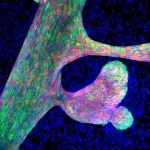$8.1 billion in damages from Hurricane Sandy directly linked to human-caused climate change
Novel modeling of sea level rise impacts by Stevens Institute of Technology researcher and collaborators creates framework for assessing human-caused damage of past and future coastal storms
2021-05-18
(Press-News.org) Research to be published tomorrow in the journal Nature Communications is the first study to quantify the costs of storm damage caused by sea level rise driven specifically by human-induced climate change. Researchers from Stevens Institute of Technology, Climate Central, Rutgers University and other institutions found this self-inflicted damage to be $8.1 billion of Hurricane Sandy's damage and an additional 71,000 people and 36,000 homes exposed to Sandy's flooding.
Hurricane Sandy struck the northeast U.S. coast in 2012, causing widespread destruction estimated at $62.7 billion. This new research not only reveals that 13 percent of the total damages resulted from human-caused sea level rise, but also reports novel modeling techniques that can be applied to other coastal storms to determine the cost associated with human-caused warming of the planet.
"This study is the first to isolate the human-contributed sea level rise effects during a coastal storm and put a dollar sign to the additional flooding damage," said Philip Orton, research associate professor at Stevens and a co-author of the study. "With coastal flooding increasingly impacting communities and causing widespread destruction, pinpointing the financial toll and the lives affected by climate change will hopefully add urgency to our efforts to reduce it."
In their work, the team found that human-caused warming had raised New York-area sea levels roughly four inches over the century preceding the storm, or about 55 percent of all sea level rise observed in the area since 1900. The higher sea levels in New York, New Jersey and Connecticut meant that the storm surge could penetrate further inland than it otherwise would have been able to --enough to deepen flood waters everywhere, increasing damage to submerged structures.
Damage estimates of human-caused sea level rise were based on hydrodynamic modeling to simulate the effect of various sea levels on the impacts of Sandy-driven flooding in the tri-state area, while accounting for natural land subsidence and all-natural components of ocean warming. A damage model was used to develop a range of dollar value estimates attributable to damages caused by anthropogenic sea level rise, with $8.1 billion representing the central estimate.
In the future, the researchers hope to apply this approach to assessing the financial and human costs of human-caused sea level rise to other regions, including the Gulf of Mexico.
"If we were to calculate the costs of climate change across all flooding events - both nuisance floods and those caused by extreme storm events - that figure would be enormous," said Orton. "It would provide clarity on the severe damage we are inflicting on ourselves and our planet."
INFORMATION:
ELSE PRESS RELEASES FROM THIS DATE:
2021-05-18
BOSTON - Prompted by a recent alarming rise in cases of colorectal cancer in people younger than 50, an independent expert panel has recommended that individuals of average risk for the disease begin screening exams at 45 years of age instead of the traditional 50.
The guideline changes by the U.S. Preventive Services Task Force (USPSTF), published in the current issue of JAMA, updates its 2016 recommendations and aligns them with those of the American Cancer Society, which lowered the age for initiation of screening to 45 years in 2018.
Colorectal cancer (CRC) is one of the most preventable malignancies, owing to its long natural history of progression and the availability ...
2021-05-18
CLEVELAND - According to new study results, a team of researchers led by Cleveland Clinic's Thaddeus Stappenbeck, M.D., Ph.D., have found that a diet high in fat and sugar is associated with impaired intestinal immune cell function in mice. The findings, published in Cell Host & Microbe, provide novel insights into pathways linking obesity and disease-driving gut inflammation, and have implications for developing targets to treat inflammatory bowel diseases (IBD) in patients.
Using data from more than 900 patients, the researchers found that elevated body mass index is associated with abnormal Paneth cells among patients with Crohn's disease and non-IBD patients.
Paneth cells are a type of anti-inflammatory immune cell found in ...
2021-05-18
Eating a Western diet impairs the immune system in the gut in ways that could increase risk of infection and inflammatory bowel disease, according to a study from researchers at Washington University School of Medicine in St. Louis and Cleveland Clinic.
The study, in mice and people, showed that a diet high in sugar and fat causes damage to Paneth cells, immune cells in the gut that help keep inflammation in check. When Paneth cells aren't functioning properly, the gut immune system is excessively prone to inflammation, putting people at risk of inflammatory bowel disease and undermining effective control of disease-causing microbes. The findings, published May 18 in Cell Host & Microbe, open up new approaches to regulating gut immunity by restoring normal Paneth cell function.
"Inflammatory ...
2021-05-18
Scientists led by Dr. Salvador Aznar-Benitah, head of the Stem Cells and Cancer laboratory at IRB Barcelona, have described the alterations that occur during mammary gland formation when heterochromatin (the part of DNA that does not actively produce proteins) is poorly regulated. The results, which have been published in the journal Cell Stem Cell, indicate that incorrect DNA packaging makes retrotransposons (a type of transposable element originated in ancestral fragments of viruses integrated into the cell genome) more accessible.
As these fragments are more accessible, they can be "read" and copied ...
2021-05-18
The frequency and intensity of heat waves in cities is increasing due to climate change, with a great negative impact on the health and mortality rates of the population. Anthropogenic activities and urban materials affect heat accumulation in cities, and solar radiation stored throughout the day on asphalt and buildings is released slowly during the night, generating significant heat stress. To face this growing problem, cities must establish effective mitigation strategies that allow reducing the temperature during heat waves.
A study carried out by researchers from the Institut de Ciència i Tecnologia Ambientals ...
2021-05-18
As lockdown measures ease this week in the UK, environmental psychologists are urging that before rushing back to business as normal, we take advantage of the shifts observed over the past year to lock-in new, greener behaviours.
Writing in the journal END ...
2021-05-18
HAMILTON, ON May 18, 2021 -- Five years after the disastrous wildfire in Fort McMurray, Alberta, researchers are warning that the complex role of peatlands, a factor critical to projecting the risk and behaviour of future fires, is missing from the forecasting model.
The Fort McMurray fire burned out of control from May 1 to July 5, 2016, though it continued to smoulder until it was finally declared extinguished Aug. 2, 2017.
Peat deposits - which are prevalent across Canada, especially in Alberta - are complex threats that can complicate and magnify the risk of severe, long-lasting fires and heavy smoke, but they are not yet part of the standard assessment tools that fire managers use.
It's a critical ...
2021-05-18
A study published this May in the journal Clinical Infectious Diseases suggests that people who have had dengue in the past are twice as likely to develop symptoms of COVID-19 if they are infected by the novel coronavirus.
The findings of the study were based on an analysis of blood samples from 1,285 inhabitants of Mâncio Lima, a small town in the state of Acre, part of Brazil’s Amazon region. The principal investigator was Marcelo Urbano Ferreira, a professor at the University of São Paulo’s Biomedical Sciences Institute (ICB-USP) in Brazil. The study was supported by FAPESP.
“Our results show that the populations most exposed to dengue, possibly owing to socio-demographic factors, are precisely ...
2021-05-18
COLUMBUS, Ohio - With pandemic lockdowns still in place last summer, The Ohio State University couldn't host its in-person Summer Success Program to help preschoolers from low-income families prepare for kindergarten.
Staff and teachers quickly pivoted to a fully virtual program, but they were worried: Could this really work with 4- and 5-year-olds who had no previous experience with preschool?
A new study suggested it did.
Researchers found that the reimagined Summer Success at Home program was feasible to operate, was popular with teachers and parents, and had at least modest success in helping the children learn ...
2021-05-18
MINNEAPOLIS/ST. PAUL (03/18/2021) -- A research team, led by the University of Minnesota Medical School, found that regardless of socioeconomic status, Twin Cities residents of underrepresented racial and ethnic backgrounds endure worse COVID-19 outcomes compared to people who are white.
The study was just published in the Journal of General Internal Medicine and is one of the first papers to discuss which social and cultural factors, including non-English speaking, may or may not contribute to racial and ethnic health disparities related to COVID-19.
"For people of color, even in the highest socioeconomic status, our data shows they still have worse COVID-19 outcomes compared to people who are white," said Nicholas Ingraham, MD, a third-year fellow in the ...
LAST 30 PRESS RELEASES:
[Press-News.org] $8.1 billion in damages from Hurricane Sandy directly linked to human-caused climate change
Novel modeling of sea level rise impacts by Stevens Institute of Technology researcher and collaborators creates framework for assessing human-caused damage of past and future coastal storms



